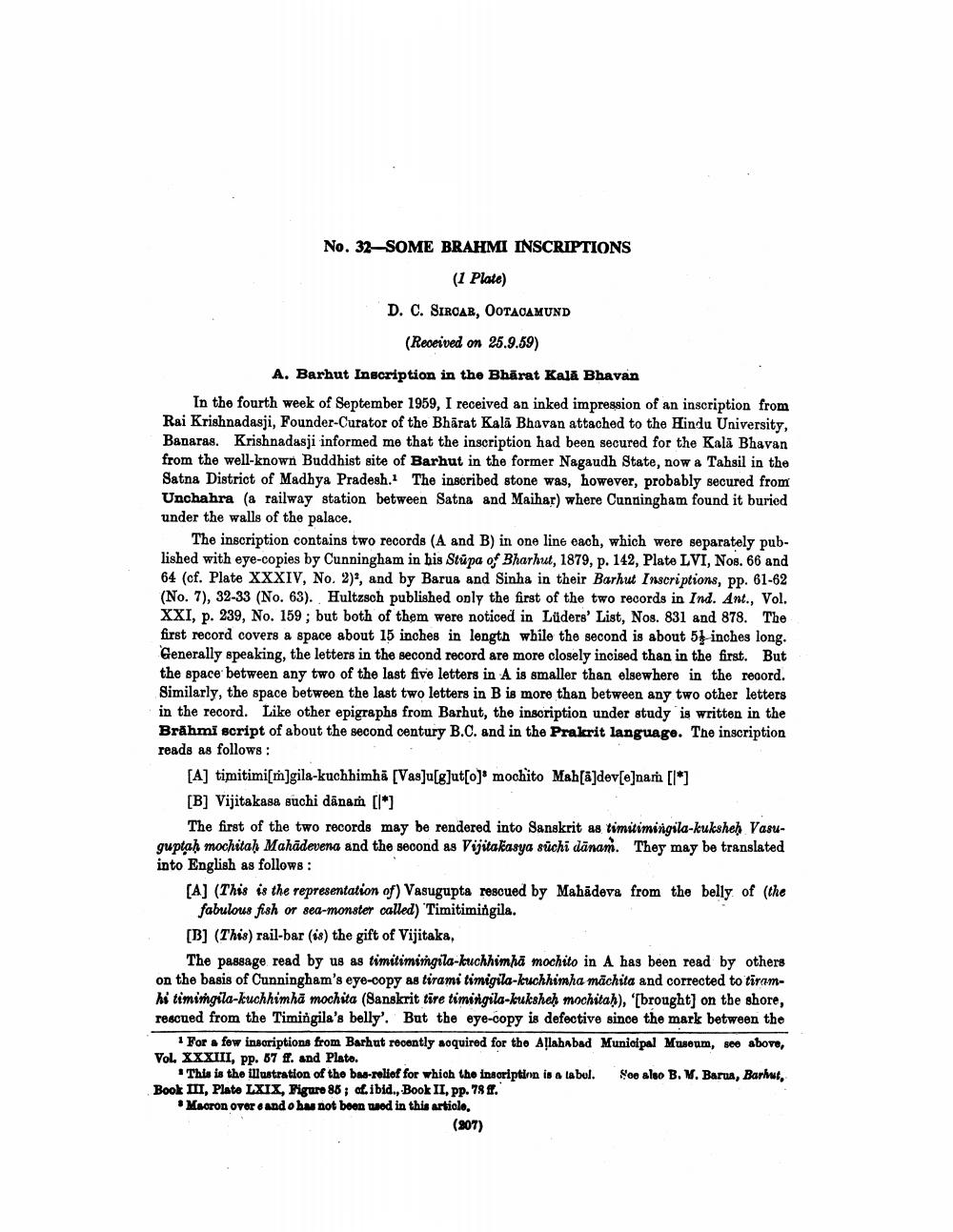________________
No. 32-SOME BRAHMI INSCRIPTIONS
(1 Plate) D. C. SIRCAR, OOTACAMUND
(Received on 25.9.59) A. Barhut Inscription in the Bharat Kala Bhavan In the fourth week of September 1959, I received an inked impression of an inscription from Rai Krishnadasji, Founder-Curator of the Bhārat Kalā Bhavan attached to the Hindu University, Banaras. Krishnadasji informed me that the inscription had been secured for the Kala Bhavan from the well-known Buddhist site of Barhut in the former Nagaudh State, now a Tahsil in the Satna District of Madhya Pradesh. The inscribed stone was, however, probably secured from Unchahra (a railway station between Satna and Maihar) where Cunningham found it buried under the walls of the palace.
The inscription contains two records (A and B) in one line each, which were separately published with eye-copies by Cunningham in his Stupa of Bharhut, 1879, p. 142, Plate LVI, Nos. 66 and 64 (cf. Plate XXXIV, No. 2), and by Barua and Sinha in their Barhut Inscriptions, pp. 61-62 (No. 7), 32-33 (No. 63). Hultzsch published only the first of the two records in Ind. Ant., Vol. XXI, p. 239, No. 159; but both of them were noticed in Lüders' List, Nos. 831 and 878. The first record covers a space about 15 inches in length while the second is about 5 inches long. Generally speaking, the letters in the second record are more closely incised than in the first. But the space between any two of the last five letters in A is smaller than elsewhere in the record. Similarly, the space between the last two letters in B is more than between any two other letters in the record. Like other epigraphs from Barhut, the inscription under study is written in the Brähmi script of about the second century B.C. and in the Pralcrit language. The inscription reads as follows:
[A] timitimi[m]gila-kuchhimha [Vas]u[g]ut[o] mochito Mah[@]dev[e]nar [l*] [B] Vijitakasa suchi dānam [l*]
The first of the two records may be rendered into Sanskrit as timitimingila-kuksheh Vasuguptaḥ mochitaḥ Mahādevena and the second as Vijitakasya süchi dānam. They may be translated into English as follows:
[A] (This is the representation of) Vasugupta rescued by Mahadeva from the belly of the
fabulous fish or sea-monster called) Timitimingila. [B] (This) rail-bar (18) the gift of Vijitaka,
The passage read by us as timitimingila-kuchhimhā mochito in A has been read by others on the basis of Cunningham's eye-copy as tirami timigila-kuchhimha măchita and corrected to tiramhi timingila-kuchhimha mochita (Sanskrit tire timingila-kuksheh mochitah), '[brought] on the shore, rescued from the Timingila's belly'. But the eye-copy is defective since the mark between the
1 Forfow inscriptions from Barhut recently aoquired for tho Aslahabad Municipal Museum, seo above, Vol. XXXIII, pp. 67 ff. and Plato.
* This is the illustration of the bas-relief for which the inscription is a labol. op also B. M. Barua, Barhwt. Book III, Plate LXIX, Figure 85 ; cf. ibid., Book II, pp. 78 ff. • Macron ovore and has not been wed in this article.
(207)




